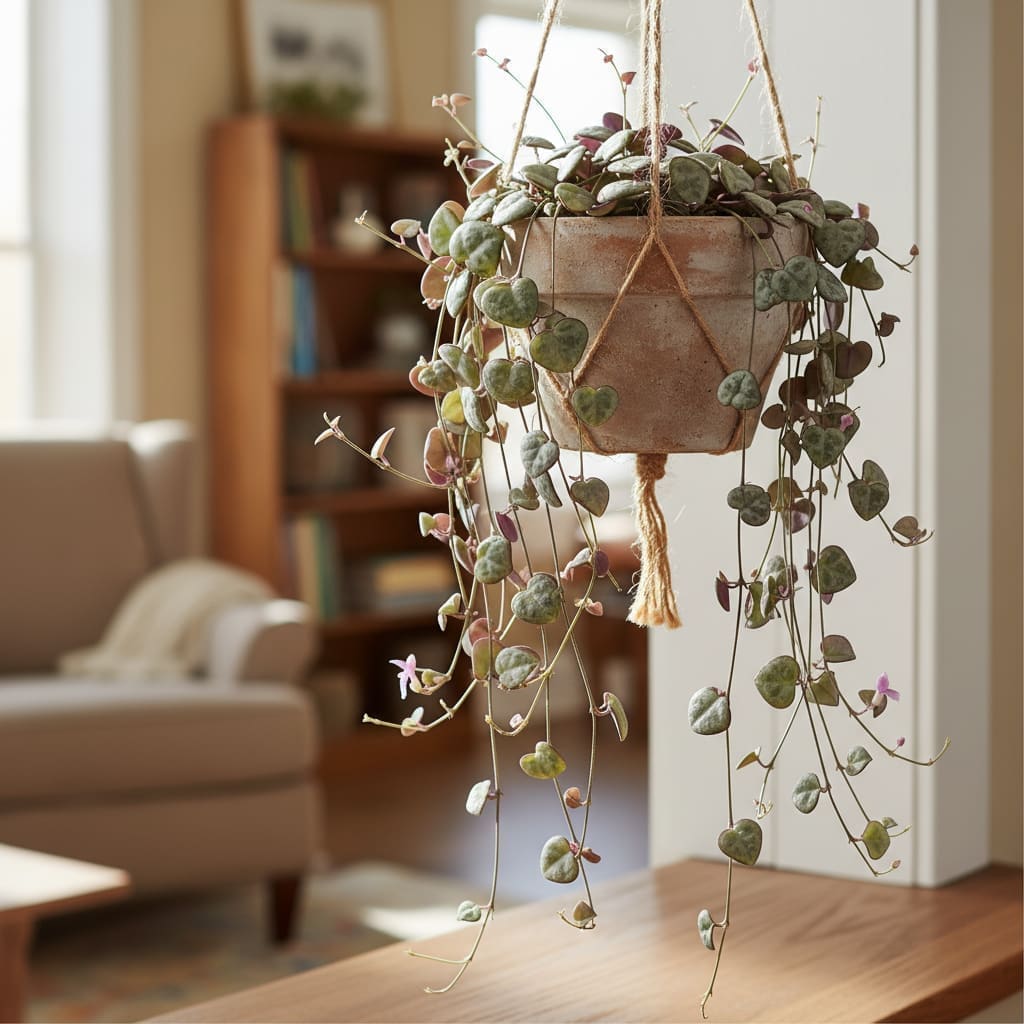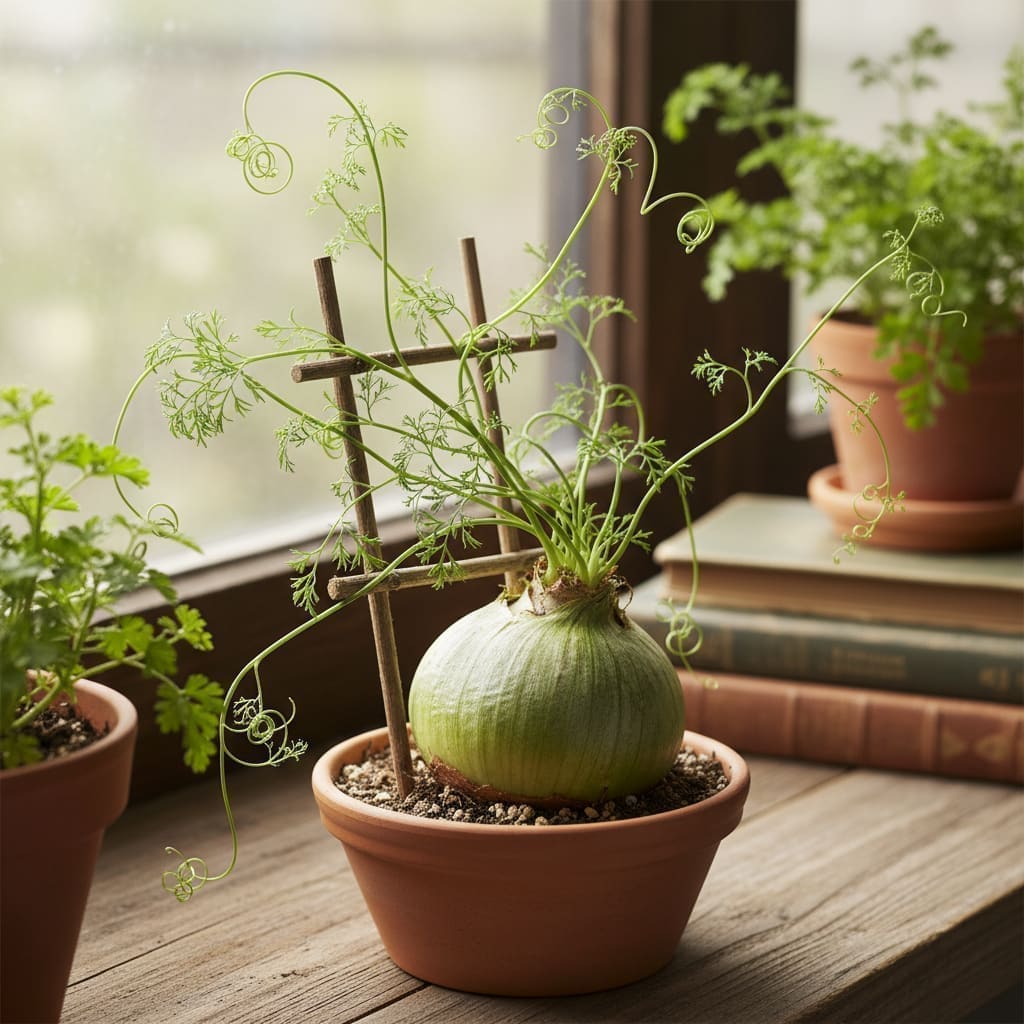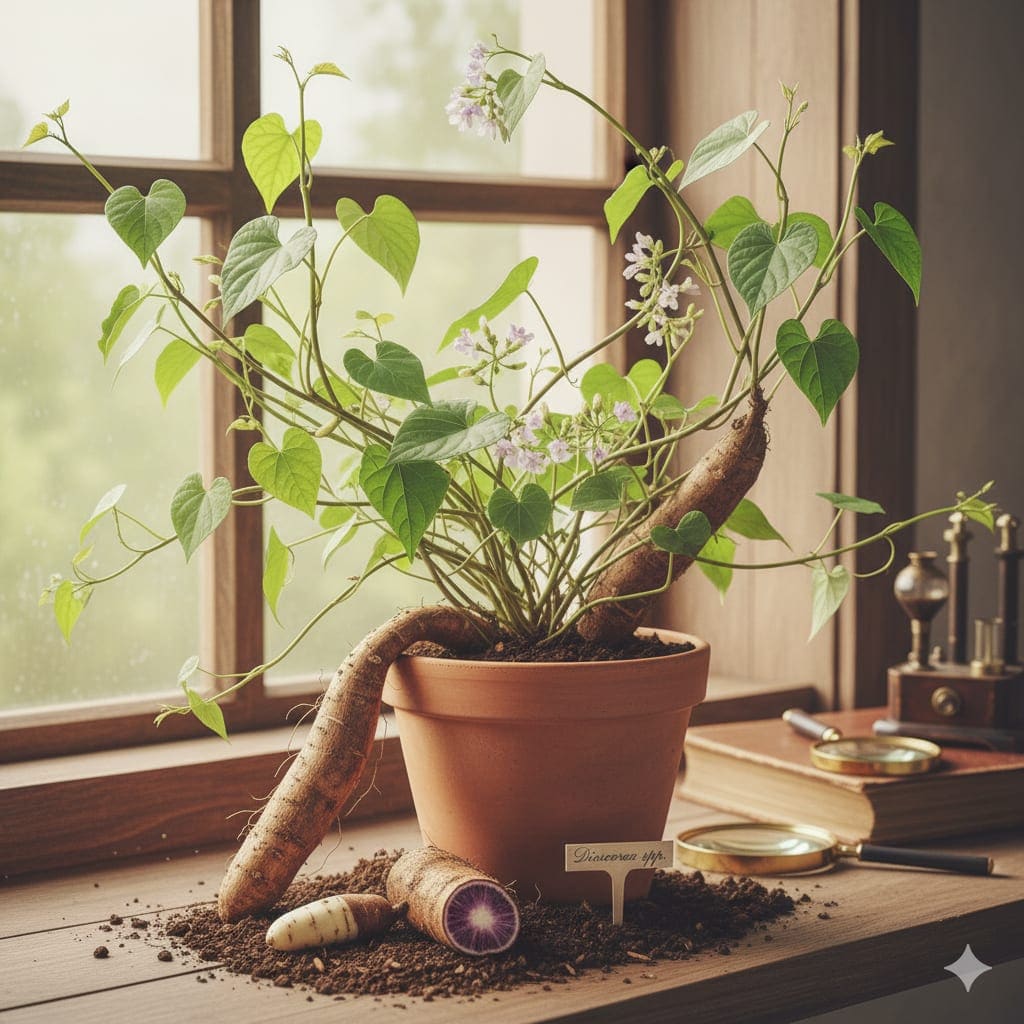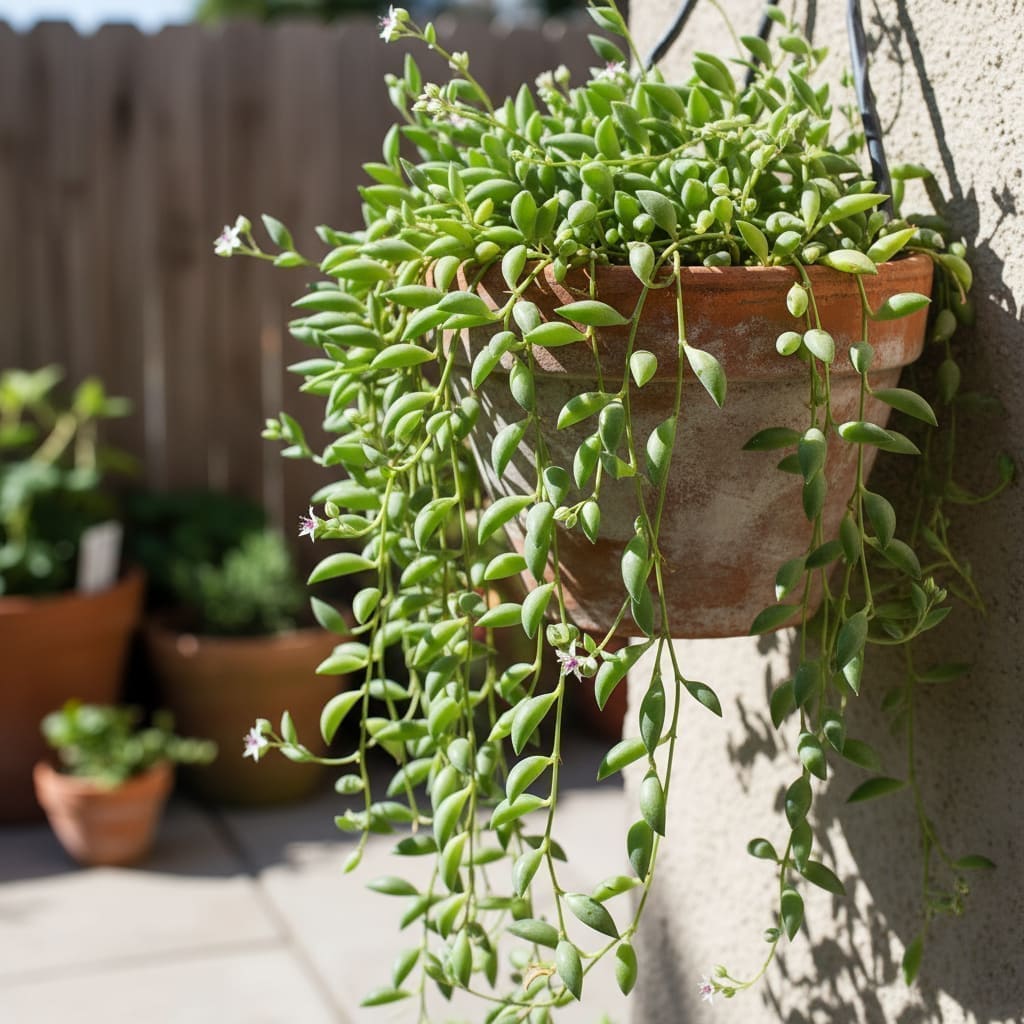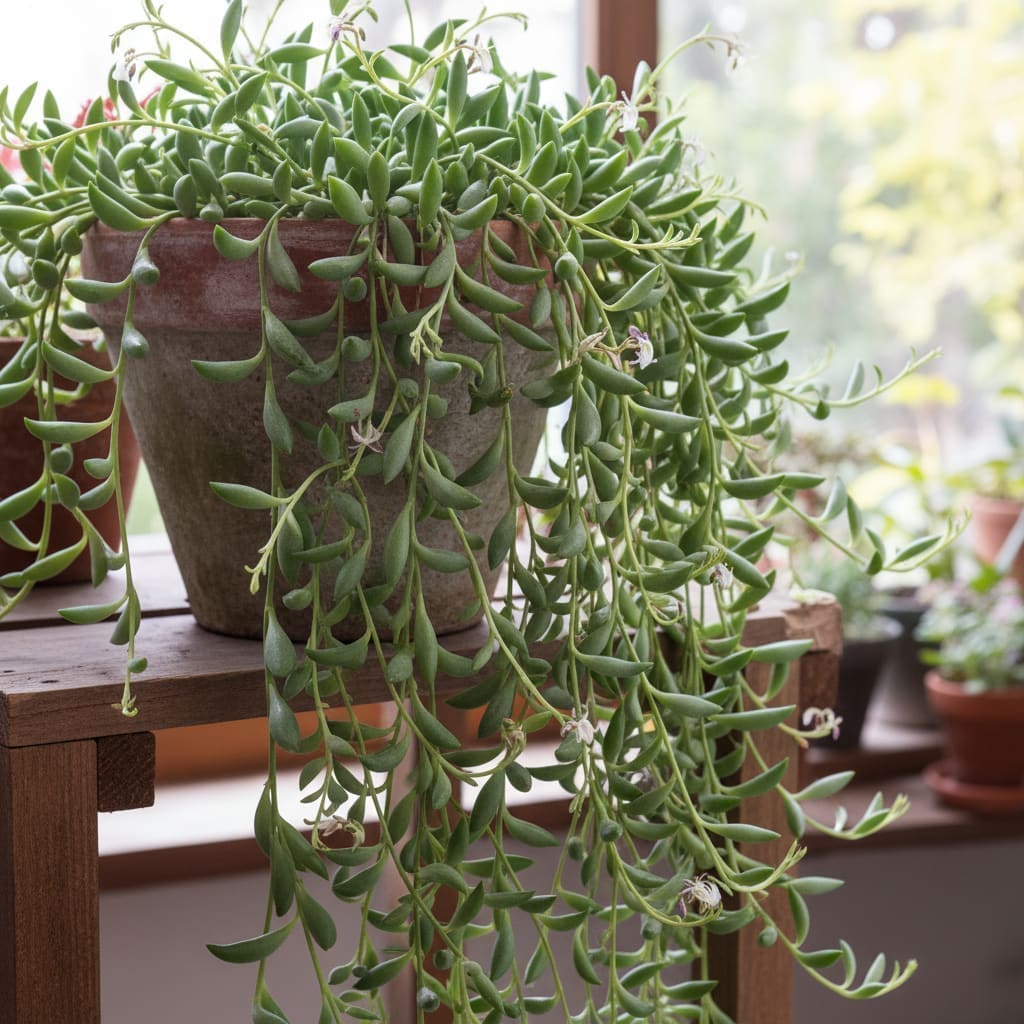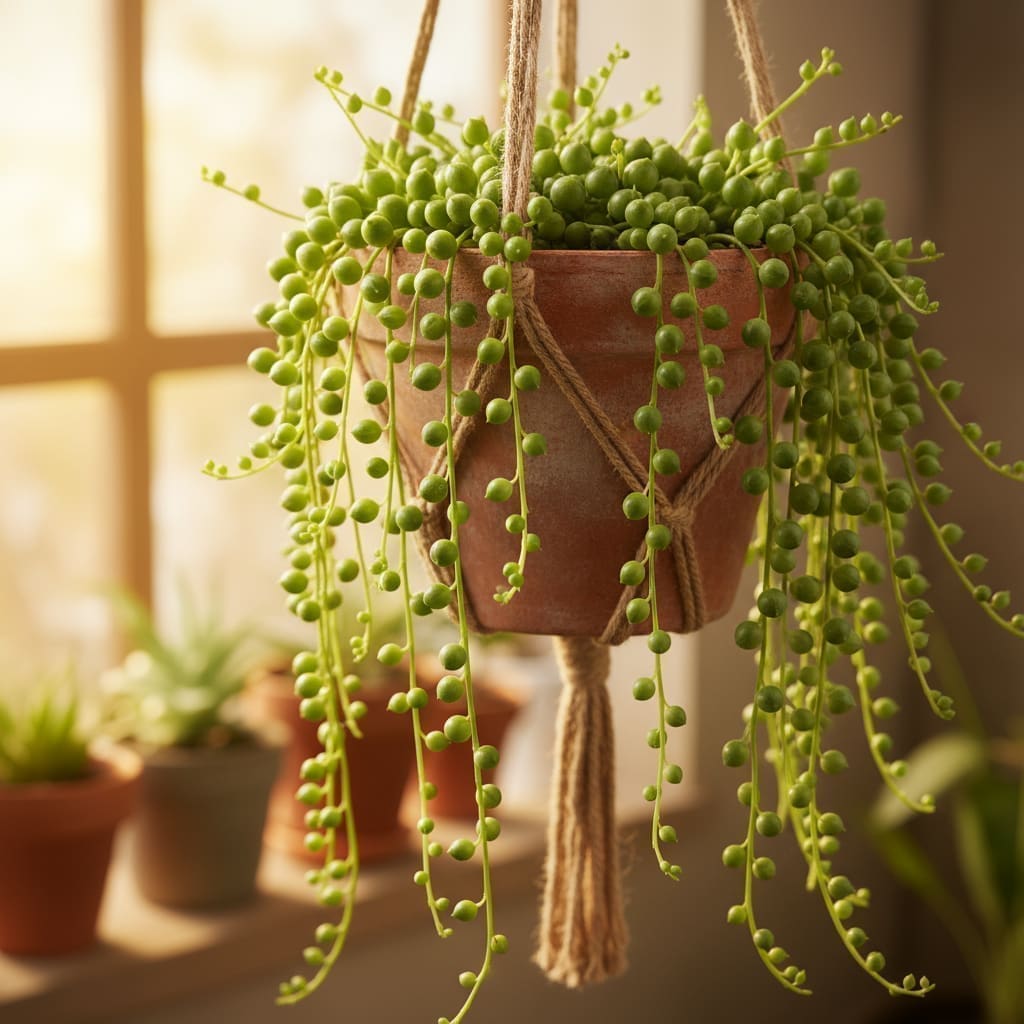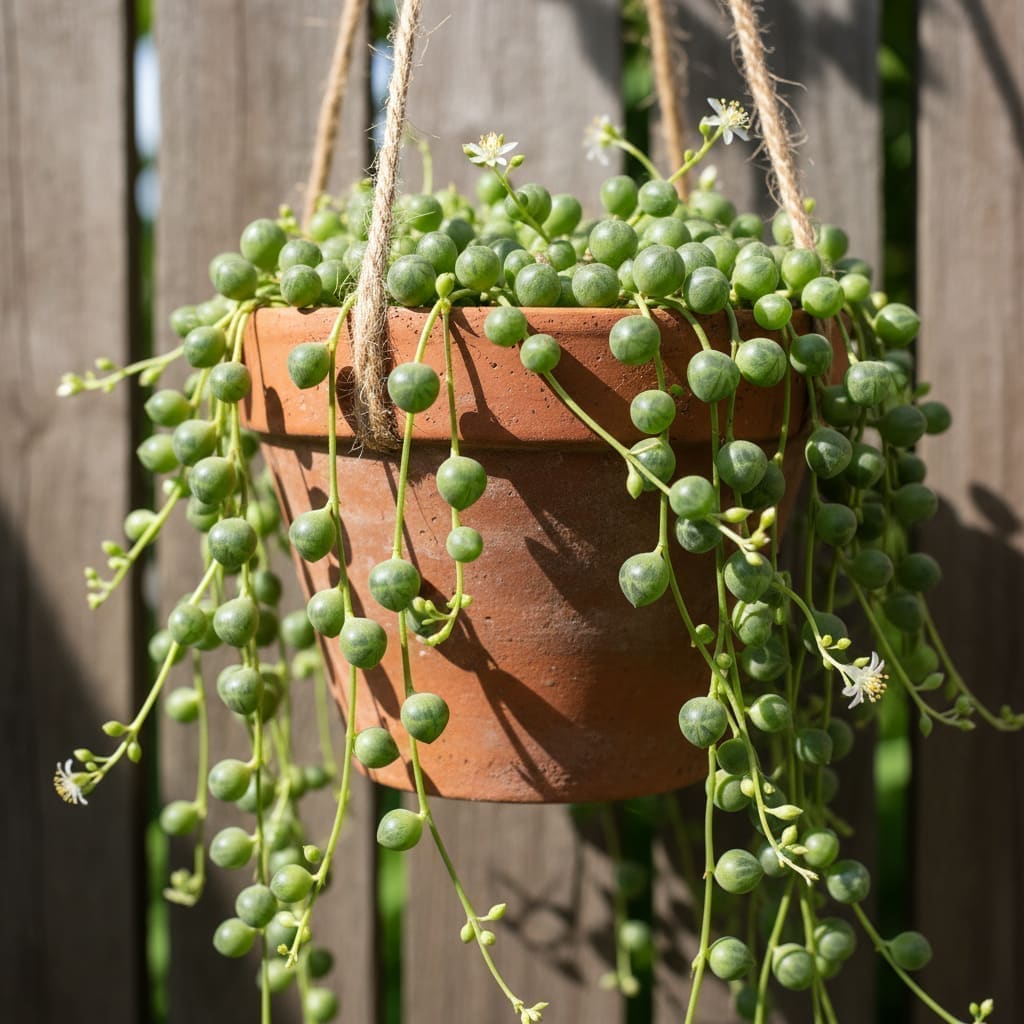Ceropegia woodii (String of Hearts) Care & Growing Guide
Overview
Ceropegia woodii, commonly known as the String of Hearts, is a trailing succulent-like vine prized for its delicate, heart-shaped leaves and cascading growth habit. Native to South Africa, Eswatini, and Zimbabwe, this plant is a member of the Apocynaceae family. It is well-suited to indoor cultivation due to its tolerance for bright, indirect light and low water needs. With proper care, it can produce small, tubular flowers and bead-like tubers along its stems, making it both ornamental and easy to propagate.
Identification & Growth Habit
The String of Hearts features slender, wiry stems that can trail or climb several feet. Leaves are opposite, heart-shaped, and typically marbled with silver on the upper surface and purple on the underside. In bright conditions, the foliage colors intensify. The plant produces small, lantern-shaped flowers in shades of pink to magenta. It naturally grows as a trailing plant but can be trained to climb a trellis, moss pole, or wire frame.
Light & Placement
- Optimal light: Bright, indirect light encourages compact growth and vibrant leaf coloration.
- Tolerances: Can handle some gentle morning or late afternoon sun; avoid harsh midday rays that may scorch leaves.
- Indoor placement: Near an east- or south-facing window with sheer curtains is ideal.
Watering & Humidity
Allow the soil to dry out completely between waterings. During the active growing season (spring and summer), water thoroughly, letting excess drain away. In winter, reduce watering frequency significantly as the plant enters a semi-dormant state. Overwatering is the most common cause of decline, leading to root rot.
- Humidity: Average household humidity is sufficient.
- Winter care: Avoid high humidity in dormancy to reduce fungal risk.
Soil & Repotting
Use a well-draining mix such as cactus or succulent soil. Incorporating perlite or coarse sand improves aeration and drainage. Repot only when the plant becomes root-bound or the soil has degraded, typically every 2–3 years. Choose a pot with drainage holes to prevent water accumulation.
Fertilizing
Feed during the growing season with a balanced, water-soluble fertilizer diluted to half strength every 4–6 weeks. Avoid fertilizing in fall and winter. Excess nitrogen can cause leggy growth and reduce leaf variegation.
Pruning & Training
Prune to control length, encourage branching, and maintain a tidy appearance. Use clean, sharp scissors to trim stems just above a leaf node. The String of Hearts can be trained to climb by gently attaching vines to a trellis, moss pole, or hoop. Alternatively, allow stems to cascade from hanging baskets for a dramatic effect.
Propagation
Stem Cuttings
- Select a healthy vine and cut a segment 4–6 inches long with at least a few nodes.
- Remove leaves from the bottom node(s).
- Place cuttings in water or directly into moist, well-draining soil.
- If rooting in water, change the water every few days; roots should appear in 2–4 weeks.
- Once roots are established, pot into a small container with succulent mix.
Tuber Planting
- Locate bead-like tubers along the vine.
- Detach tubers with a small section of stem.
- Plant tubers just beneath the soil surface in a small pot.
- Water lightly and keep in bright, indirect light until new growth emerges.
Common Problems
- Root rot: Caused by overwatering or poor drainage. Remedy by trimming affected roots and repotting in fresh, dry soil.
- Leaf yellowing: Often from excess moisture or low light. Adjust watering schedule and increase light exposure.
- Pests: Mealybugs, aphids, and spider mites may appear. Treat with insecticidal soap or neem oil, and isolate affected plants.
- Leggy growth: Typically due to insufficient light. Move to a brighter location.
Toxicity & Pet Safety
Ceropegia woodii is considered toxic if ingested by pets or humans. Keep out of reach of cats, dogs, and small children. Symptoms may include gastrointestinal upset. Consult a veterinarian if ingestion is suspected.
Styling & Decor Tips
- Display in a hanging basket to showcase its trailing vines.
- Train onto a circular hoop for a living wreath effect.
- Combine with other trailing succulents for a mixed arrangement.
- Use as a cascading accent on shelves or plant stands.
Varieties & Cultivars
- Ceropegia woodii variegata: Features cream, pink, and green marbled foliage.
- Ceropegia woodii 'Silver Glory': Larger, rounder leaves with pronounced silver patterning.
Buying Tips & Maturity
When purchasing, look for firm, plump leaves with vibrant coloration and no signs of pests. Avoid plants with mushy stems or yellowing foliage. Mature plants have longer, fuller vines and may produce flowers and tubers more readily than young specimens.
Seasonal Care
- Spring/Summer: Active growth; water regularly (allowing soil to dry between waterings), fertilize monthly, and provide bright light.
- Fall: Gradually reduce watering and stop fertilizing as growth slows.
- Winter: Minimal watering; keep in a bright spot with moderate temperatures. Avoid cold drafts and high humidity.
FAQ
How fast does Ceropegia woodii grow?
In optimal conditions, it can produce several feet of new growth in a single season, especially in bright, indirect light.
Can String of Hearts grow in low light?
It will survive in lower light but may become leggy and lose variegation. Bright, indirect light is best for compact, colorful growth.
Why are my String of Hearts leaves curling?
Leaf curling can result from underwatering, excessive heat, or sudden environmental changes. Check soil moisture and adjust care accordingly.
Do I need to mist my String of Hearts?
No, average household humidity is sufficient, and misting is generally unnecessary. Excess moisture on leaves can promote fungal issues.
When will my String of Hearts flower?
Flowering typically occurs in late summer to fall under good light and care conditions, though not all indoor plants bloom regularly.
Sources: Wikipedia, The Spruce
Troubleshooting Scenarios
- Wrinkled leaves with dry soil: Indicates prolonged underwatering; soak thoroughly and resume regular checks.
- Soft, mushy leaves with wet soil: Suggests overwatering; remove damaged stems and allow soil to dry completely before next watering.
- Faded leaf markings despite bright light: May be due to nutrient depletion; apply a diluted balanced fertilizer during active growth.
- Sudden leaf drop after relocation: Plant is adjusting to environmental change; maintain stable conditions and avoid further disturbance.
Advanced Pruning & Training
For fuller baskets, pinch back vine tips regularly to stimulate lateral shoots. Advanced growers can create intricate shapes by weaving pliable stems through wire frames, securing with soft plant ties. Periodic selective pruning of older, woody stems encourages fresh, vigorous growth and maintains aesthetic balance.
Pest & Disease Quick-Reference
- Mealybugs: White, cottony clusters on stems and leaf axils; treat with cotton swab dipped in alcohol.
- Spider mites: Fine webbing and speckled leaves; increase humidity slightly and use miticide if needed.
- Aphids: Small green or black insects on new growth; rinse off with water or apply insecticidal soap.
- Fungal leaf spots: Brown or black lesions; remove affected leaves and improve air circulation.
Companion Plant Suggestions
Pair String of Hearts with plants that share similar light and water needs for cohesive displays. Good companions include:
- Senecio rowleyanus (String of Pearls) for contrasting bead-like foliage.
- Hoya carnosa for waxy, star-shaped flowers and complementary trailing habit.
- Peperomia prostrata (String of Turtles) for small, patterned leaves in mixed arrangements.
